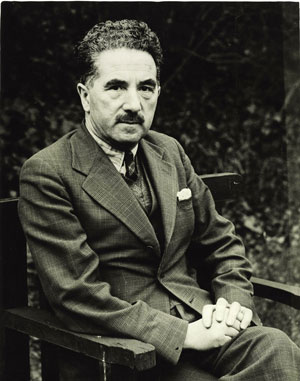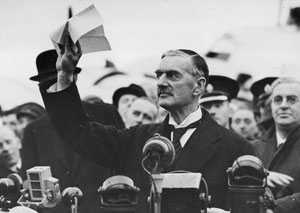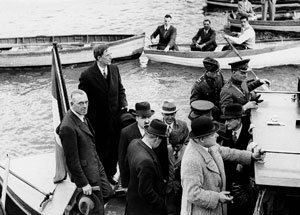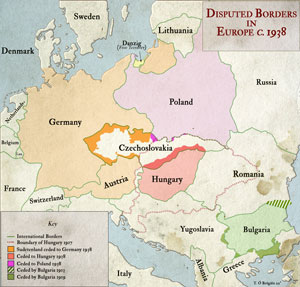IRELAND AND EAST CENTRAL EUROPE: PARALLELS IN BORDER REVISION
Published in Features, Issue 1 (January/February 2023), Volume 31By Erik Stewart

Above: Secretary of the Department of External Affairs Joseph Walshe—following his first meeting with Eamon de Valera in 1932, after the latter became taoiseach, he was sure that his primary objective was Ireland’s reunification.
Living in an age when aggressive territorial land-grabs have once again become topical issues of the day forces one to reflect on the last time events of this nature were commonplace in Europe. Such reflections quickly lead one to the conclusion that Ireland was not as far removed from such events as it might at first appear. In 1938 the Nazi government was calling for the cession of the Sudetenland in Czechoslovakia owing to its ethnic German majority population, and it seemed increasingly likely that this demand would be granted. This scenario, however, motivated other nations with territorial issues of their own, namely Poland, Hungary and eventually others, to seek the same treatment for their own territorial grievances. While the Czechoslovak crisis is often viewed as a Continental crisis, it was also followed intensely in Irish political circles for the same reasons as it was in Poland, Hungary and elsewhere.
‘THE BALKANISATION OF ULSTER’

Above: ‘Peace in our time’—British Prime Minister Neville Chamberlain at Heston Aerodrome following his return from Munich on 30 September 1938. (Alamy)
This was because, while the crisis posed an undeniable threat to world peace, the logic of its resolution appealed to those seeking to end partition in Ireland. An examination of how nationalist sentiment influenced Irish foreign policy in the lead-up to the Sudetenland crisis can shine new light on Ireland’s relationship with the interwar phenomenon of territorial revisionism. Irish nationalists and politicians had long been drawing attention to supposed parallels and analogies between the partition situation in Ireland and the territorial and minority questions of East Central Europe. In advance of the Anglo-Irish Treaty negotiations in 1921, eminent nationalist Eoin MacNeill produced a handwritten memorandum entitled ‘The Balkanisation of Ulster’. He described the process of ‘Balkanisation’ as the ‘forcible separation from national rights in any area in which the majority of the inhabitants are opposed to the separation or do not positively demand it’, and argued that such a process was being applied to the Catholic nationalist minority in Northern Ireland.
Similarly, another typescript memorandum entitled ‘Ulster: Minority Parallels in Europe’, unsigned and undated but labelled as belonging to the Irish delegation to the 1921 Treaty negotiations, was produced. This examined the nature of minority questions across Europe, such as those in Poland and Czechoslovakia. Of particular interest was the way in which those issues arose in the first place. For example, in discussion of the Posen region, the fact that it was granted to Poland ‘without a plebiscite’ is highlighted in the original document. It seems that those negotiating on behalf of the would-be Irish Free State were looking to compare minority questions in Europe with those in Ulster in the hope of avoiding what they saw as an unjust resolution to the Ulster Question, especially where the Catholic and nationalist communities were concerned.
THE SUDETENLAND CRISIS AND PARTITION

Above: Taking over the Treaty Ports—Taoiseach Eamon de Valera leads a delegation to Spike Island on 11 July 1938 following the Anglo-Irish Agreement. He later lamented the fact that the ending of partition had no place in it. (Irish Press)
Partition and the controversy it provoked had only occurred barely seventeen years prior to the Sudetenland crisis. Thus it would be natural for such things and their possible rectification to still occupy the minds of the Irish public and government. Following his first meeting with Eamon de Valera in 1932, after the latter became taoiseach, Secretary of the Department of External Affairs Joseph Walshe was sure that his primary objective was Ireland’s reunification. This assumption quickly seemed accurate, as de Valera, also serving as Minister for External Affairs, made it his mission to gradually dismantle elements of the 1921 Anglo-Irish Treaty. Considering that de Valera led those who opposed the Anglo-Irish Treaty and partition both politically and militarily, such things seem natural. Indeed, on one occasion, during a public radio broadcast to the United States, de Valera referred to partition as the ‘worst crime committed by British statesmen against Ireland’.
One need look no further than the Anglo-Irish negotiations of spring 1938 to see the extent to which desire for reunification influenced Irish foreign policy at the time. It was recommended to de Valera just prior to those negotiations that the partition question ‘ought to come last’ on the agenda, but according to the minutes of the first meeting in those negotiations partition was one of the first issues mentioned. The fact that de Valera went against the advice of his senior civil servants in this instance illustrates the importance he placed on the ending of partition. It is also important to note that the nationalistic goals of the Irish delegation involved in those negotiations were apparently shared by much of the population throughout Ireland.
When questioned by Neville Chamberlain, also present throughout the 1938 negotiations, on the extent to which Ireland’s population saw Britain as opposed to a united Ireland, de Valera explained that ‘this view was held universally in Éire. Public opinion would never credit the United Kingdom Government with any different policy.’ De Valera and those directly involved in the direction of Irish foreign policy were not acting out of some selfish desire either. Nationalist elements, both public and political, on both sides of the partition boundary attentively followed the negotiations with hopes that they would bring an end to partition. It is also clear from these negotiations that the Irish government was not afraid to make international appeals if they believed that it would aid in achieving their goals.
AMERICAN OPINION
Joseph Walshe believed that ‘American opinion is playing a very important part in the negotiations’ and suggested that ‘if the responsible American press could be induced to continue the campaign in favour of unity as a factor of world peace, I have a very real hope that the British will take some substantial step toward the desired goal’. Such an appeal took place days later—not to the press, however, but to President Franklin D. Roosevelt himself. In a letter of 25 January 1938, speaking of how ‘another opportunity for finally ending the quarrel of centuries between Britain and Ireland’ had presented itself, de Valera appealed, albeit fruitlessly, to Roosevelt to intervene in the effort to end partition.
Lamenting the supposed fact that the British were unappreciative of the ‘great results that would follow a complete reconciliation between the two peoples’, de Valera asked Roosevelt whether he could not use his ‘influence to get the British government to realise what would be gained by reconciliation and to get them to move whilst there is time’. In addition, de Valera incessantly urged the British government to somehow convince its Northern Ireland counterpart to consider reunification, and even sent Dominions Secretary Malcolm MacDonald handwritten drafts of the kind of declaration that he believed might motivate such things.
In a follow-up letter to Roosevelt on 22 April, the taoiseach lamented the fact that the ending of partition had no place in the new Anglo-Irish Agreement. De Valera could merely ‘hope that the present agreement will be a step towards’ reunification. Nationalist groups in the north also expressed ‘intense’ disappointment at the lack of progress made towards ending partition. The Derry People and Tirconaill News praised de Valera’s achievements in the negotiations but nevertheless emphasised that further action on ending partition was required. The latter remained de Valera’s primary political objective, for in a personal note to himself he wrote:
‘… now that partition has been isolated as the one remaining obstacle to a final reconciliation between the two nations the efforts of all the people of goodwill will be directed towards removing it’.
TERRITORIAL REVISIONISM IN EUROPE
Such fervent desire for revision of territorial issues arising from a peace treaty was not unique to Ireland. Poland, Hungary and Bulgaria also found their territorial composition greatly affected by their own post-war peace treaties, and these issues remained on the minds of policy-makers in these nations in 1938. A closer comparative analysis simultaneously reveals both similarities and differences between the influence of territorial revisionist desires in interwar Ireland and those in Poland, Hungary and Bulgaria.
While the territorial arrangements of these four nations, as they stood on the eve of the Sudeten crisis in 1938, were the product of various post-war peace treaties, the historical and cultural paths that had led them to that result are vastly different. Many of East Central Europe’s interwar minority questions resulted from the ethnic diversity of late empires’ territories. Poland had been divided between the German, Russian and Austro-Hungarian empires for centuries, and only formally gained its independence following the Treaty of Versailles (1919). The emergence of new states and the post-war rearranging of borders scattered Polish minorities throughout various nations. The Teschen (Zaolzie in Polish) region, inhabited by over 140,000 Poles, was occupied by Czechoslovakia and no diplomatic progress could be made by Poland to gain it. The Treaty of Trianon (1920) divided up swathes of Hungarian territory among several newly independent nations now on its borders. This was viewed as a ‘crime’ by much of the population, and demand for revision emerged almost instantly—not unlike the Irish public’s reception of the Anglo-Irish Treaty. For its siding with the defeated Central Powers during the war, Bulgaria had vast sections of economically desirable territory redivided amongst its new neighbours as a consequence of the Treaty of Neuilly-sur-Seine (1919).
SIMILAR ARGUMENTS AGAINST PARTITION IN IRELAND
Despite clear differences in the basis for the claims, arguments for the ending of partition in Ireland were nevertheless often based on the same logic as the revisionist arguments of East Central European states. These often revolved around geographic, historical, political and cultural reasoning—all of which formed elements of Irish anti-partition rhetoric in the interwar period. Many East Central European governments found themselves vying for the return of several regions, with disagreement often arising over the question of how much revision should take place. In Ireland there was only one area to struggle for, and thus the revisionist objective was clear.
The ethno-geographical diversity of Eastern Europe meant that any rearranging of borders was highly unlikely to satisfy all involved. In Ireland it was not ethnic or cultural diversity that made resolving partition difficult but the stark and centuries-long divide between two opposite political and religious ideologies. Most minorities of the newly partitioned states across Europe in the post-war period had been rendered so against their will—a trait shared by the Irish Catholics and nationalists in Northern Ireland. Despite the exact details and context behind these forceful separations being rather different, their impacts were quite similar. In both Ireland and East Central Europe, these events further radicalised elements of the nationalist movement and to some extent the population at large. In all cases, campaigns of propaganda and agitation were launched by the relevant majority government in attempts to make some headway in recovering territories from which it had been separated.
In terms of similarities, both Ireland and its post-imperial counterparts in Europe sported both ‘activist’ and ‘passive’ revisionist groups. The former sought to use more aggressive, often violent, means to achieve their aims, while the latter sought to do so through diplomacy. Prior to the Anglo-Irish Treaty, activist means had been the primary tool of the Irish nationalist movement. Since then, however, and especially by the time of the Sudeten crisis, revision of the Northern Ireland border was sought through passive, diplomatic means, while only marginal groups, such as the IRA, continued activist pursuits.
For much of the interwar period Hungary and Bulgaria followed a similar path, choosing either to cultivate positive relations with their newly independent neighbour states in the hope of one day facilitating peaceful negotiation on the revision of borders or to propose various peaceful plans for a return to their previous territorial arrangements in a vein similar to that of de Valera in the 1938 Anglo-Irish negotiations. Bulgaria, however, was also home to ultranationalist militant groups that targeted other ethnic groups to force border revision. This often undermined any revisionist progress made through legitimate diplomatic channels. In early 1939 an IRA bombing campaign would have the same effect on the anti-partition movement.
AUTONOMY?
The political goal of several minority groups in East Central Europe, such as the Sudetenland Germans or Transylvanian Hungarians, was, for a time at least, autonomous administration and cooperation with the majority government. While similar objectives were sought in pre-war Ireland, most prominently in the form of Home Rule, by the time of the Sudetenland crisis no such thing was on the table. Instead, full separation from British administration was the goal for the Six Counties.
With both similarities and differences, comparative analyses between the interwar territorial questions of Ireland and several fledgling East Central European nations make for revealing discussions on the influence of nationalism and the desire for territorial revision on government policy. The dramatic land-grabs of Nazi Germany and Fascist Italy in the late 1930s would garner increasing attention from those seeking territorial revision of their own in Ireland and elsewhere. To some it signalled a potential opportunity, while others feared the ramifications of an increasingly likely European war. Reactions in Irish political circles to the Sudeten crisis were a contradictory mix of pragmatism and opportunism, which merits further study to recontextualise Ireland’s relationship with Continental developments at this time.
Erik Stewart has an MA in History from Maynooth University.
Further reading
M. Kennedy, Ireland and the League of Nations, 1919–1946: international relations, diplomacy and politics (Dublin, 1996).
D. Keogh, Ireland and Europe, 1919–1948 (Dublin, 1988).
D. McCullagh, De Valera, Volume II: Rule, 1932–1975 (Dublin, 2018).
M. O’Driscoll, Ireland, Germany and the Nazis: politics and diplomacy, 1919–1939 (2nd edn) (Dublin, 2017).

















